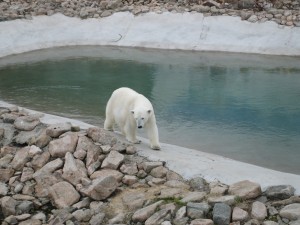On March 31st Malla and the cub came out through the door and the cub met the world outside the den for the first time. The surrounding was all snow and the cub seemed a little anxious and it made a lot of voices. The video of the little cub can be seen here. Malla and her cub were kept in a smaller fence while the male bears Jehu and Palle-Jooseppi were out in a bigger fence. Malla also wanted out to the bigger fence and as she was let out there it happened she was stressed of the situation and abandoned her cub and run out and did not show any interest towards the cub any more. She acted even aggressively towards her cub and the staff at the zoo found it best to take the cub from her, for the safety of the cub. So at the moment the cub is fed by the staff of the zoo and will not be brought back to the mum any more. The mother will not recognize her own cub anymore and she will act aggressively towards a stranger. A name competition will be arranged on the home page of Ranua wildlife park to find a name for the little female bear. If everything works out fine, the cub can probably be seen in the zoo in the beginning of summer. These abandoning behaviors happened either because Malla was an unexperienced mother or due to other stress factors. In the nature she could even kill her cub, but that is now prevented by the decision to take the cub from her. Let us see how this will work out.
The father Jehu has woken up from the hibernation already and was anxiously waiting outside the den for Malla and the cub to come out to him***.
It is amazing how tiny a brown bear cub is at birth. You may think a big bear could give birth to a much bigger cub, but the newborn is really tiny and spends many weeks on mummy’s stomach, where it gets breast-fed, and kept warm in the warm fur of mummy. In the blog from Ranua zoo you can see for yourself the amazing video from the birth of the brown bear cub and also how it has grown during the first month. It is impossible to decide the sex of the cub until it comes out from the den.
In the wolverine fence you also find only the father Rasputin running around. The female wolverine Batsi has actually also given birth to two tiny wolverine cubs and is spending time with them inside an underground den breast-feeding. The wolverine cubs were born during the weekend on March 8-9 and were caught by a camera. The cubs weight around 100 g each. In the nature the wolverine gives birth inside a cavern made of snow. Last time there were wolverine cubs in Ranua was over 10 years ago, in 2003, so this is a very special moment and predicts a busy summer with a lot of interested visitors for the wildlife park.
Another thing that happens in the near future at Ranua zoo is that the two years old polar bear Ranzo is going to leave the zoo and move to the zoo Schönbrunn in Vienna, Austria, in the beginning of May. In the zoo Schönbrunn they are building a new Polar bear world, Franz Josef Land, which will open in April. Ranzo will meet an adorable Polar bear girl, Lynn, also 2 years old, and they will hopefully be parents next year. Ranzo’s move to Vienna is quite natural, as his grandmother, Vienna, was born there. So he returns to his roots, so to say. Still Ranzo is happily unknown of his coming destiny playing with his toys in Ranua zoo.
This picture is of Ranzo and his mother last spring. 
At the moment Ranzo is alone in his fence, while his mother Venus has moved over to his father Manasse’s fence and they are enjoying each others’ company at the moment. New polar bear cubs are of course expected next winter from these meetings. You can look at a video from their meetings also from the blog.
*** Unfortunately the brown bear Jehu found a way out from his fence to the freedom in the end of April 2014. The staff of the zoo has a special security plan for incidences like this regarding brown bears’, polar bears’ and muskoxes’ escapes and the only thing was to shoot the Jehu bear, to avoid danger to people outside the zoo. The brown bear Jehu never met the new cub.














